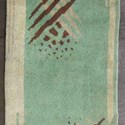Although unsigned, the carpet in Germany - rug specialists have termed it 'The Third Man' - is the sibling of the enigmatic pair of rugs that first emerged in 2008 when consigned to Netherhampton Saleroom, near Salisbury by a Portobello Road dealer.
Francis Bacon's early career as an interior decorator and furniture designer is documented but, partly because the artist later sought to destroy the evidence (he described his efforts as poor imitations of the generic Cubist style), only a handful of objects have survived.
Correspondence with the Francis Bacon Foundation in 2008 had raised the possibility that the so-called 'Netherhampton' pair, measuring 5ft 5in x 3ft (1.65m x 91cm) and 7ft 4in x 3ft (2.24m x 91cm), might be among Bacon's earliest works (perhaps made c.1929 after he returned from Paris and Berlin).
Both were signed in the weave with the bold signatures that do appear on some of the half-dozen undisputed Bacon rugs.
However, as previously reported in ATG, they have since been twice withdrawn from sale: at Netherhampton Salerooms in March 2009 (when the estimate was £50,000-80,000) and again this September at Newcastle auctioneers Anderson & Garland (when the estimate of £180,000-220,000).
The third rug, which lacks a signature, comes up for sale at carpet specialists Rippon Boswell's sale in Wiesbaden on November 24. Consigned from a UK private collection, it was fully considered in an article on Bacon textiles penned by Berkshire dealer Clive Rogers and Jean Manuel de Noronha and published in Hali magazine (number 162).
Structurally it is thought to be identical to the Netherhampton pair that, in the yarns, knotting technique, pile and handle, show significant differences to the few Bacon rugs known to have been made at the Royal Wilton Carpet factory or one of its rural outposts c.1929-1931*.
The article found them comparable to the work of the Killybegs factory in Co. Donegal and demonstrated that the original design was created c.1927 by the Brazilian-born Art Deco textile artist Ivan da Silva Bruhns (1880-1980).
"This third rug makes the point that these three (and maybe more as yet undiscovered) are in marked contrast to the unique and one-off Wilton rugs designed by Bacon," comments Clive Rogers.
Detlef Maltzahn, auctioneer and specialist at Rippon Boswell, told ATG the rug is certainly of the period, although much inferior to Wilton weaving. A theory he finds plausible is that these relatively crude Irish rugs represent the first moment in Bacon's career in soft furnishings, with the unsigned rug perhaps an early prototype. The estimate is €40,000.
* These include a 6ft 7in by 3ft 11in (2 x 1.20m) handwoven Modernist wool carpet c.1929, boldly signed Francis Bacon in the weave, sold at Christie's Paris in March 2011 for a premium-inclusive €109,000 as part of Les Collections du Château de Gourdon. A documentary photograph of around 1932 showed this rug, or at least one of identical design, in the living room of Bacon's Carlyle Studios, Chelsea.








